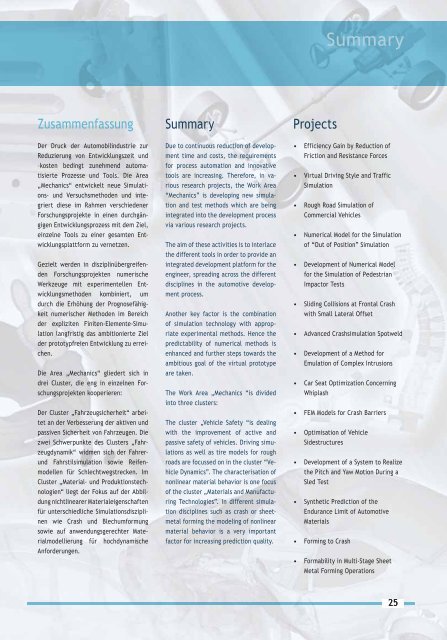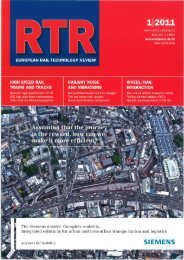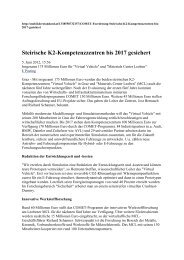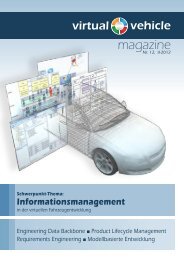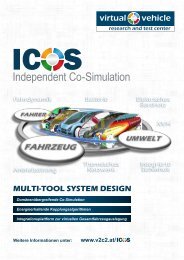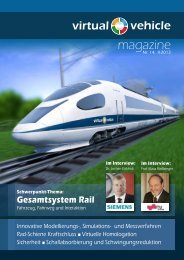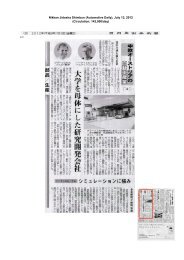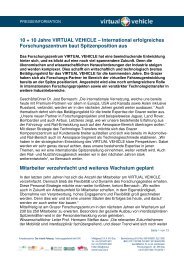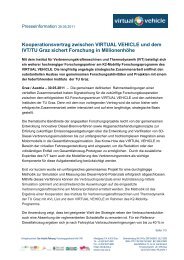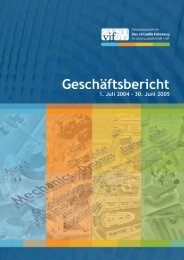Technical Architecture - Virtual Vehicle
Technical Architecture - Virtual Vehicle
Technical Architecture - Virtual Vehicle
Erfolgreiche ePaper selbst erstellen
Machen Sie aus Ihren PDF Publikationen ein blätterbares Flipbook mit unserer einzigartigen Google optimierten e-Paper Software.
Zusammenfassung<br />
Der Druck der Automobilindustrie zur<br />
Reduzierung von Entwicklungszeit und<br />
–kosten bedingt zunehmend automatisierte<br />
Prozesse und Tools. Die Area<br />
„Mechanics“ entwickelt neue Simulations-<br />
und Versuchsmethoden und integriert<br />
diese im Rahmen verschiedener<br />
Forschungsprojekte in einen durchgängigen<br />
Entwicklungsprozess mit dem Ziel,<br />
einzelne Tools zu einer gesamten Entwicklungsplattform<br />
zu vernetzen.<br />
Gezielt werden in disziplinübergreifenden<br />
Forschungsprojekten numerische<br />
Werkzeuge mit experimentellen Entwicklungsmethoden<br />
kombiniert, um<br />
durch die Erhöhung der Prognosefähigkeit<br />
numerischer Methoden im Bereich<br />
der expliziten Finiten-Elemente-Simulation<br />
langfristig das ambitionierte Ziel<br />
der prototypfreien Entwicklung zu erreichen.<br />
Die Area „Mechanics“ gliedert sich in<br />
drei Cluster, die eng in einzelnen Forschungsprojekten<br />
kooperieren:<br />
Der Cluster „Fahrzeugsicherheit“ arbeitet<br />
an der Verbesserung der aktiven und<br />
passiven Sicherheit von Fahrzeugen. Die<br />
zwei Schwerpunkte des Clusters „Fahrzeugdynamik“<br />
widmen sich der Fahrer-<br />
und Fahrstilsimulation sowie Reifenmodellen<br />
für Schlechtwegstrecken. Im<br />
Cluster „Material- und Produktionstechnologien“<br />
liegt der Fokus auf der Abbildung<br />
nichtlinearer Materialeigenschaften<br />
für unterschiedliche Simulationsdisziplinen<br />
wie Crash und Blechumformung<br />
sowie auf anwendungsgerechter Materialmodellierung<br />
für hochdynamische<br />
Anforderungen.<br />
Summary<br />
Due to continuous reduction of development<br />
time and costs, the requirements<br />
for process automation and innovative<br />
tools are increasing. Therefore, in various<br />
research projects, the Work Area<br />
“Mechanics” is developing new simulation<br />
and test methods which are being<br />
integrated into the development process<br />
via various research projects.<br />
The aim of these activities is to interlace<br />
the different tools in order to provide an<br />
integrated development platform for the<br />
engineer, spreading across the different<br />
disciplines in the automotive development<br />
process.<br />
Another key factor is the combination<br />
of simulation technology with appropriate<br />
experimental methods. Hence the<br />
predictability of numerical methods is<br />
enhanced and further steps towards the<br />
ambitious goal of the virtual prototype<br />
are taken.<br />
The Work Area „Mechanics “is divided<br />
into three clusters:<br />
The cluster „<strong>Vehicle</strong> Safety “is dealing<br />
with the improvement of active and<br />
passive safety of vehicles. Driving simulations<br />
as well as tire models for rough<br />
roads are focussed on in the cluster “<strong>Vehicle</strong><br />
Dynamics”. The characterisation of<br />
nonlinear material behavior is one focus<br />
of the cluster „Materials and Manufacturing<br />
Technologies”. In different simulation<br />
disciplines such as crash or sheetmetal<br />
forming the modeling of nonlinear<br />
material behavior is a very important<br />
factor for increasing prediction quality.<br />
Projects<br />
•<br />
•<br />
•<br />
•<br />
•<br />
•<br />
•<br />
•<br />
•<br />
•<br />
•<br />
•<br />
•<br />
•<br />
•<br />
Summary<br />
Efficiency Gain by Reduction of<br />
Friction and Resistance Forces<br />
<strong>Virtual</strong> Driving Style and Traffic<br />
Simulation<br />
Rough Road Simulation of<br />
Commercial <strong>Vehicle</strong>s<br />
Numerical Model for the Simulation<br />
of “Out of Position” Simulation<br />
Development of Numerical Model<br />
for the Simulation of Pedestrian<br />
Impactor Tests<br />
Sliding Collisions at Frontal Crash<br />
with Small Lateral Offset<br />
Advanced Crashsimulation Spotweld<br />
Development of a Method for<br />
Emulation of Complex Intrusions<br />
Car Seat Optimization Concerning<br />
Whiplash<br />
FEM Models for Crash Barriers<br />
Optimisation of <strong>Vehicle</strong><br />
Sidestructures<br />
Development of a System to Realize<br />
the Pitch and Yaw Motion During a<br />
Sled Test<br />
Synthetic Prediction of the<br />
Endurance Limit of Automotive<br />
Materials<br />
Forming to Crash<br />
Formability in Multi-Stage Sheet<br />
Metal Forming Operations<br />
25


